-
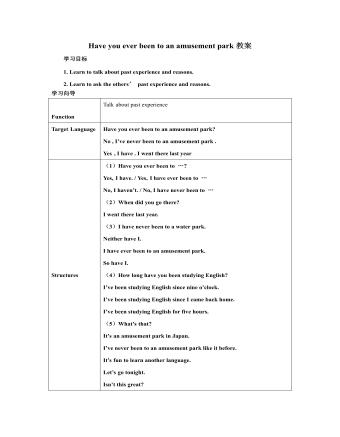
人教版新目标初中英语八年级下册Have you ever been to an amusement park教案
(1)Have you ever been to …? Yes, I have. / Yes, I have ever been to …No, I haven’t. / No, I have never been to …(2)When did you go there? I went there last year. (3)I have never been to a water park. Neither have I. I have ever been to an amusement park. So have I. (4)How long have you been studying English? I’ve been studying English since nine o’clock. I’ve been studying English since I came back home. I’ve been studying English for five hours. (5)What’s that? It’s an amusement park in Japan. I’ve never been to an amusement park like it before. It’s fun to learn another language. Let’s go tonight. Isn’t this great?space museum, amusement park, water park, South America, Peru, Holland, European culture, tour guide, flight attendant, musical instrument, more than, be from, get to, take lessons, neither, discover, graduate, change
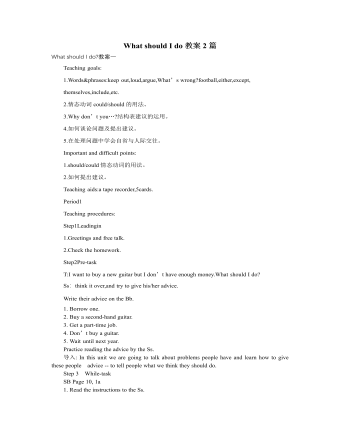
人教版新目标初中英语八年级下册What should I do教案2篇
说明:在帮Li Lei提建议的同时,教育学生如何学好英语。第三课时教学目标1. 语言目标:a) 词汇: Original, in style, haircut, the same as.b) 语言结构:My friend wears the same clothes and has the same haircut as I do.2. 能力目标:大多数学生能够谈论自己喜欢哪种服装,提高查找信息的能力。3. 情感目标:学会如何与朋友相处,要有自己对时尚的看法。教学重点掌握一些重要词汇。教学难点学会谈论问题,并能提出书面建议。◆教学突破首先针对Erin的问题,提出个人的建议,模仿2c部分的对话展开双人交际Pair-work;听老师诵读3a部分的信件,并找出LEFT OUT的问题所在;学生完成3b部分的内容,给Left Out提出书面的建议;学以口头形式提出自己目前存在的某个问题,讲给大家听,让同学们给自己提出一个建议,并作笔录;学生两、三个人分成一组,随意性地进行口语交际,谈论P14的第4部分的某个问题,相互交换意见。
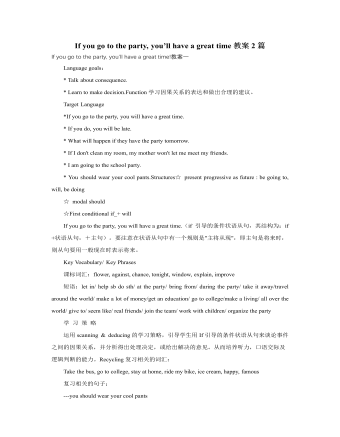
人教版新目标初中英语八年级下册If you go to the party, you’ll have a great time教案2篇
区分宾语从句、定于从句和状语从句宾语从句和状语从句,都叫做主从复合句。宾语从句主要是中考必考的,是初中阶段必掌握的从句,宾语从句主要是掌握三要素,所谓宾语从句,就是宾语在主从复合句当中充当宾语的一个句子,叫做宾语从句。主句的谓语动词是及物动词,后面如果是词或者是短语的话,是简单句,如果是句子的话,肯定是宾语从句。I know that he good at English.就是宾语从句,三要素,一要素是要注意连词,连词一共学了三类连词,一类连词是that口语当中可以省略,就像刚才说的那一句,I hear he is good at English.还有疑问代词、疑问副词,how where when,疑问代词、疑问副词。还有一类连词weather是否的意思,不是状语从句当中的如果,这一定要和如果区分开,这是是否。I don't know if he interested at English。宾语从句要注意if是连词。第二要素是语序,要用陈述举语序。比如说你家有几口人,我们都说How many people are there in you family?但是这是简单句,一旦说成宾语从句,你可以告诉我你家有几口人吗?Could you tell me how many people there are in you family ?
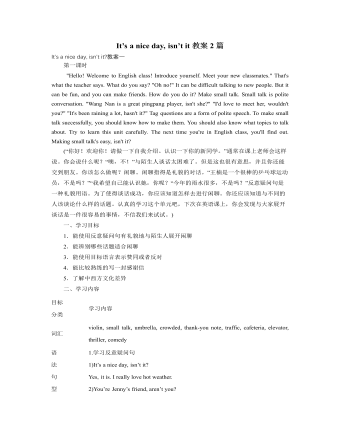
人教版新目标初中英语八年级下册It’s a nice day, isn’t it教案2篇
"Hello! Welcome to English class! Introduce yourself. Meet your new classmates." That's what the teacher says. What do you say? "Oh no!" It can be difficult talking to new people. But it can be fun, and you can make friends. How do you do it? Make small talk. Small talk is polite conversation. "Wang Nan is a great pingpang player, isn't she?" "I'd love to meet her, wouldn't you?" "It's been raining a lot, hasn't it?" Tag questions are a form of polite speech. To make small talk successfully, you should know how to make them. You should also know what topics to talk about. Try to learn this unit carefully. The next time you're in English class, you'll find out. Making small talk's easy, isn't it? (“你好!欢迎你!请做一下自我介绍。认识一下你的新同学。”通常在课上老师会这样说。你会说什么呢?“噢,不!”与陌生人谈话太困难了。但是这也很有意思,并且你还能交到朋友。你该怎么做呢?闲聊。闲聊指得是礼貌的对话。“王楠是一个很棒的乒乓球运动员,不是吗?”“我希望自己能认识她,你呢?“今年的雨水很多,不是吗?”反意疑问句是一种礼貌用语。为了使得谈话成功,你应该知道怎样去进行闲聊。你还应该知道与不同的人该谈论什么样的话题。认真的学习这个单元吧,下次在英语课上,你会发现与大家展开谈话是一件很容易的事情,不信我们来试试。)
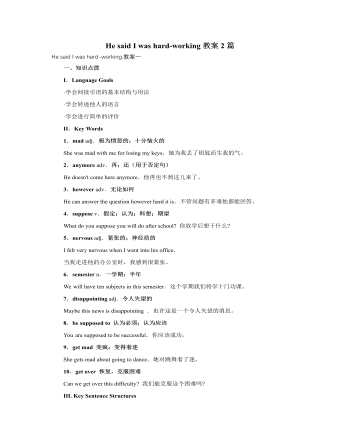
人教版新目标初中英语八年级下册He said I was hard-working教案2篇
This activity introduces some new vocabulary and provide oral practice using the target language.Task 1 . Ask four students to stand in front of the class, and the teacher asks them the following questions as a reporter.1.What are you going to do when you grow up?2.What are you going to do next week?3.What are going to do after school?The students will give different answers, then ask a good student to report what they said.I am going to e a doctor.What did she say?----------She said she was going to be a doctor.I am going to have a party on Friday night.What did he say?-------He said he was going to have a party on Friday night.I am going to do my homework.What did she say ?------ She said she was going to do her homework.I am going home after school.What did she say?-----She said she was going home after school.Say In this unit we are going to learn to use words like to report what someone said.Task 2. Read the instructions. Then ask a student to read the four questions. And write the words on the Bb. Explain what soap opera is.Task 3. Ask the students to Look at the pictures, point out the TV screens in the picture. Ask one girl to read what Marcia said.What did Marcia say? She said She said she was having a surprise party for Lana on Friday night. Repeat the other pictures in the same way.Activity3. Listen and number the pictures in activity 1a.
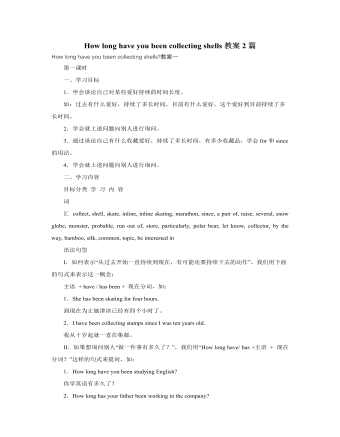
人教版新目标初中英语八年级下册How long have you been collecting shells教案2篇
Step Ⅱ Show the new words on the screen and teach the new words. Read the new words to students and ask them to repeat.Step Ⅲ 3aThis activity introduces new vocabulary and provides reading practice using the target language.In this activity first look at the four pictures.T: What can you see in the pictures?Ss: Four snow globes.T: Right. There are four snow globes in the pictures. And what are they?Ss: They are a monster, two polar bears, two penguins and a birthday cake.Write these words on the blackboard: snow globe; monster; polar bear; penguin and birthday cake. Read them to the class and ask students to repeat each one. Make sure students understand each word.Use a computer to show the E-mail message on the screen and read the message to students.Get students to read the e-mail on their own, and then draw lines connecting each snow globe and its description.Correct the answers.AnswersA line should connect each snow globe picture with the words that describe it in the letter.Step Ⅳ 3bThis activity provides writing practice using the target language.First review Activity 2a on Page 47.Then ask students to complete the message according to Activity 2a.Some partial sentences are given to students. Write about one person's collection.When students work, walk around the room checking the progress and offering help as needed.When they finish, ask some students to read their messages to the class.
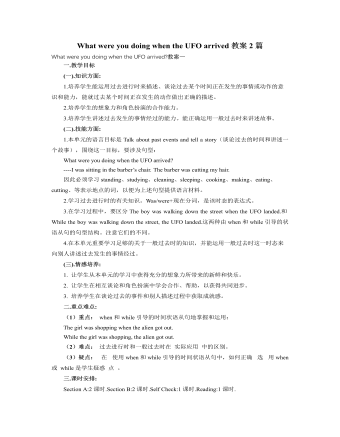
人教版新目标初中英语八年级下册What were you doing when the UFO arrived教案2篇
(一).知识方面: 1.培养学生能运用过去进行时来描述、谈论过去某个时间正在发生的事情或动作的意识和能力,能就过去某个时间正在发生的动作做出正确的描述。 2.培养学生的想象力和角色扮演的合作能力。 3.培养学生讲述过去发生的事情经过的能力。能正确运用一般过去时来讲述故事。 (二).技能方面: 1.本单元的语言目标是Talk about past events and tell a story(谈论过去的时间和讲述一个故事),围绕这一目标,要涉及句型: What were you doing when the UFO arrived? ----I was sitting in the barber’s chair. The barber was cutting my hair. 因此必须学习standing、studying、cleaning、sleeping、cooking、making、eating、cutting、等表示地点的词,以便为上述句型提供语言材料。2.学习过去进行时的有关知识。Was/were+现在分词,是该时态的表达式。 3.在学习过程中,要区分The boy was walking down the street when the UFO landed.和While the boy was walking down the street, the UFO landed.这两种由when和while引导的状语从句的句型结构。注意它们的不同。
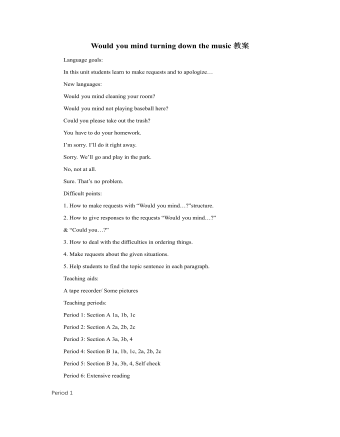
人教版新目标初中英语八年级下册Would you mind turning down the music教案
Step 4. Group work (4)1. Ask a pair of students to read the dialogue. Say, This activity provides speaking, listening and writing practice using the target language.2. Ask students to complete the work in groups.3. Check the answers with the whole class. 4. Explain some of the language points. Step 5. Word review (Self check 1)1. Ask students to read the words and the phrases given. 2. Fill in the blanks with proper forms of these words to complete the sentences. 3. Check the answers with the whole class. Homework:Do activity 2 on page 57 after class. Period 6Teaching aims: 1. Teach vocabulary words and the useful expressions. 2. Enable the students to learn etiquette in different culture. 3. Help the students learn how to behave politely in public places and in daily life. Teaching procedures:Step 1. RevisionHelp students to review the function of making requests through a free talk. Then lead them to the topic of etiquette. Explain the meaning of etiquette. Or, ask students to look it up in the dictionary. Step 2. Pre-reading (Section 1)1. Ask students to read the picture and make a list with their partner about how many rules of etiquette can be seen being broken.
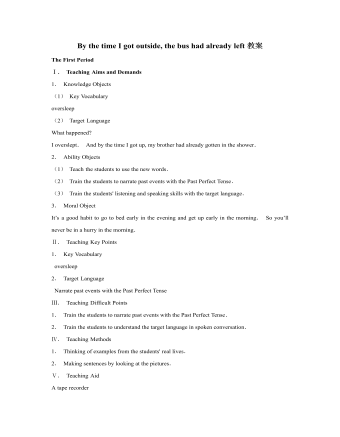
人教版新目标初中英语九年级下册By the time I got outside, the bus had already left教案
Ⅰ. Teaching Aims and Demands1. Knowledge Objects(1) Key Vocabularyoversleep(2) Target LanguageWhat happened?I overslept. And by the time I got up, my brother had already gotten in the shower.2. Ability Objects(1) Teach the students to use the new words.(2) Train the students to narrate past events with the Past Perfect Tense.(3) Train the students' listening and speaking skills with the target language.3. Moral ObjectIt’s a good habit to go to bed early in the evening and get up early in the morning. So you’ll never be in a hurry in the morning.Ⅱ. Teaching Key Points1. Key Vocabularyoversleep2. Target LanguageNarrate past events with the Past Perfect TenseⅢ. Teaching Difficult Points1. Train the students to narrate past events with the Past Perfect Tense.2. Train the students to understand the target language in spoken conversation.Ⅳ. Teaching Methods1. Thinking of examples from the students' real lives.2. Making sentences by looking at the pictures.Ⅴ. Teaching AidA tape recorderⅥ. Teaching ProceduresStep I Revision1. Revise the language points in Unit 8.Ask some questions like this: What volunteer work would you like to do?Help the students to answer, I’d like to…/I love to…/I hope to2. Practice the dialogue in Activity 3c on page 62 again. Get students to role play the similar dialogues with the following.
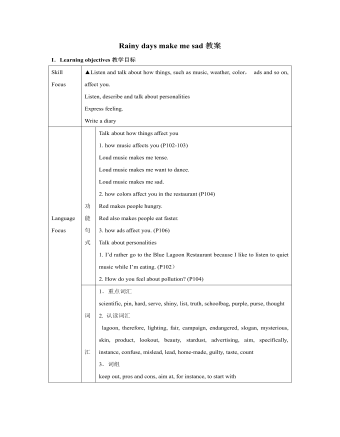
人教版新目标初中英语九年级下册Rainy days make me sad教案
1. 教材分析本单元以how do things affect you?为话题, 从颜色、天气、音乐、广告、产品等方面谈论了外界事物如何影响人的心情。要求学生掌握表达某物或某事给人带来的感觉、看法或影响等。共设计了四个部分的内容:Section A 该部分有4个模块:第一模块围绕Which restaurant would you like to go to?这一话题展开思维(1a)、听力(1b)、口语(1c)训练;第二模块围绕How does music affect you? 进行听力(2a-2b)、口语训练(2c);第三模块继续围绕how do colors in the restaurant affect you这一话题展开训练,训练形式为阅读和问题体验(3a)和小组活动(3b);第四模块仍就How do things affect you这一话题以调查的形式展开讨论。Section B该部分有4个模块:第一模块围绕产品广告对人们的影响这一话题以“配对”(1a)与“列举”(1b)两种形式展开训练;第二模块继续围绕How do things affect you? 进行听力(2a-2b)、口语对话训练(2c);第三模块围绕“Advertising”这一话题展开阅读(3a-3b)和写作(3c)训练;第四模块围绕How posters affect you这一话题以口语训练形式展开小组活动。
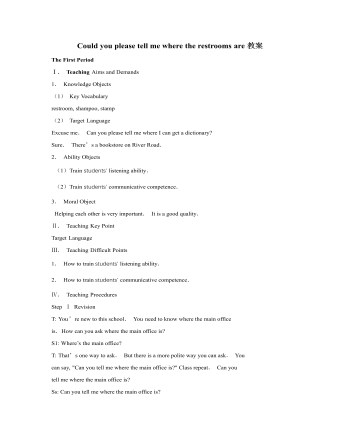
人教版新目标初中英语九年级下册Could you please tell me where the restrooms are教案
Step Ⅰ RevisionCheck homework. Ask a few students to read the article in 3a.Then ask a few students to read their guides.Step Ⅱ Part 1Look at the words in the box. Ask a student to read them. Make sure the students understand the meaning of the words. You are to fill in the blanks with the words. In some cases, students may need to use another form of the word, for example adjusting for tense or subject/ verb agreement.Ask students to fill in the blanks on their own.Check the answers. Step ⅢPart 2Go through the instructions with the class.Look at the example with the students.Ask students what the answer would be.Ask a student to read the question and answer it.Excuse me, could you tell me where the bank is, please?The bank is across the street from the shopping malt.Get students to complete the work in pairs.Check the answers. Ask a few students to read their questions.Step Ⅳ Just for Fun!Ask all the students to read the conversation. Ask: What is funny about this cartoon? Help students to explain. A Martian is a person from the planet Mars.There is no such thing as Martian food on Earth, and the clerk looks silly because he is trying to think of where there is a Martian restaurant.Invite some pairs of students to present this conversation to the rest of the class.Step Ⅴ Summary and HomeworkIn this class, we’ve done much writing practice using the key vocabulary words and the target language presented in this unit. After class, please finish the questions in 2 in your exercise books. Then finish the exercises on pages 47~48 of the workbook as well.The Seventh Period Ⅰ Teaching Aims and Demands1. Knowledge Objects(1) Key Vocabularyimage, adventure, jealousy, hero, crime, journey, brave, no longer, show interest in, take it easy, become interested in, plain looks(2)Text:Grown-ups like cartoons, too.2. Ability Objects(1) Fast-reading to get a general idea of the text.(2) Careful-reading to get the detailed information in the text.
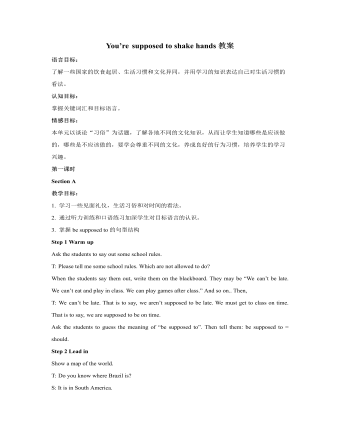
人教版新目标初中英语九年级下册You’re supposed to shake hands教案
教学目标:1. 掌握本单元一些重点词汇的写法和用法。2. 学会自如谈论餐桌礼仪。Step 1 RevisionAsk some students to retell the customs at the table in France in the passage in 3a.Step 2 Self checkPart 1. Fill in each bland with the correct word given. Students do the exercises by themselves at first. Then check the answers. Ask the students to comprehend the sentences and help them point out uses of some words, like “arrive (at / in) sw., spend time / money on sth , spend time / money (in) doing sth.”Part 2. Read about Fan Ling’s experience in a western restaurant. Understand the passage. Point out some key points in the passage.1. be / get used to doing sth. 习惯做某事2. begin with = start with 以….开头3. crowd v. 挤满,塞满 the crowd 人群 crowded adj. 拥挤的Then students discuss about how she would solve her problem. Ask some to share their stories with others.Part 3. Complete the crossword by looking at the sentences on the left. Then check the answers.

北师大初中八年级数学下册第四章复习教案
在因式分解的几种方法中,提取公因式法师最基本的的方法,学生也很容易掌握。但在一些综合运用的题目中,学生总会易忘记先观察是否有公因式,而直接想着运用公式法分解。这样直接导致有些题目分解错误,有些题目分解不完全。所以在因式分解的步骤这一块还要继续加强。其实公式法分解因式。学生比较会将平方差和完全平方式混淆。这是对公式理解不透彻,彼此的特征区别还未真正掌握好。大体上可以从以下方面进行区分。如果是两项的平方差则在提取公因式后优先考虑平方差公式。如果是三项则优先考虑完全平方式进行因式分解。培养学生的整体观念,灵活运用公式的能力。注重总结做题步骤。这章节知识看起来很简单,但操作性很强的,相同或者相似的式子比较熟悉而需要转化的或者多种公式混合使用的式子就难以入手,基础不好的学生需要手把手的教,因此,应该引导学生总结多项式因式分解的一般步骤①如果多项式的各项有公因式,那么先提公因式;
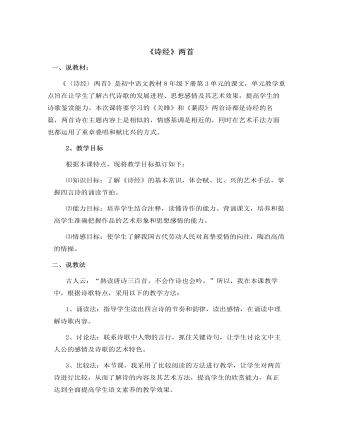
部编版语文八年级下册《诗经》二首 说课稿
一、说教材: 《〈诗经〉两首》是初中语文教材8年级下册第3单元的课文,单元教学重点旨在让学生了解古代诗歌的发展进程、思想感情及其艺术效果,提高学生的诗歌鉴赏能力。本次课将要学习的《关雎》和《蒹葭》两首诗都是诗经的名篇,两首诗在主题内容上是相似的,情感基调是相近的,同时在艺术手法方面也都运用了重章叠唱和赋比兴的方式。 2、教学目标根据本课特点,现将教学目标拟订如下:⑴知识目标:了解《诗经》的基本常识,体会赋、比、兴的艺术手法,掌握四言诗的诵读节拍。⑵能力目标:培养学生结合注释,读懂诗作的能力。背诵课文,培养和提高学生准确把握作品的艺术形象和思想感情的能力。⑶情感目标:使学生了解我国古代劳动人民对真挚爱情的向往,陶冶高尚的情操。
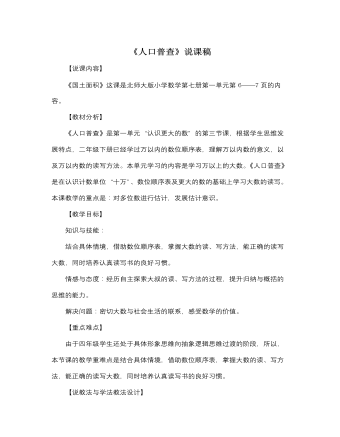
北师大版小学数学四年级上册《人口普查》说课稿
【说课内容】《国土面积》这课是北师大版小学数学第七册第一单元第6——7页的内容。【教材分析】《人口普查》是第一单元“认识更大的数”的第三节课,根据学生思维发展特点,二年级下册已经学过万以内的数位顺序表,理解万以内数的意义,以及万以内数的读写方法。本单元学习的内容是学习万以上的大数。《人口普查》是在认识计数单位“十万”、数位顺序表及更大的数的基础上学习大数的读写。本课教学的重点是:对多位数进行估计,发展估计意识。【教学目标】知识与技能:结合具体情境,借助数位顺序表,掌握大数的读、写方法,能正确的读写大数,同时培养认真读写书的良好习惯。情感与态度:经历自主探索大叔的读、写方法的过程,提升归纳与概括的思维的能力。
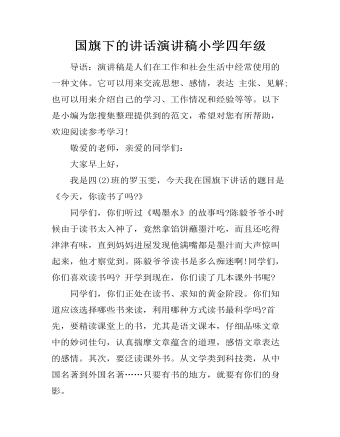
国旗下的讲话演讲稿小学四年级
导语:演讲稿是人们在工作和社会生活中经常使用的一种文体。它可以用来交流思想、感情,表达 主张、见解;也可以用来介绍自己的学习、工作情况和经验等等。以下是小编为您搜集整理提供到的范文,希望对您有所帮助,欢迎阅读参考学习!敬爱的老师,亲爱的同学们:大家早上好,我是四(2)班的罗玉雯,今天我在国旗下讲话的题目是《今天,你读书了吗?》同学们,你们听过《喝墨水》的故事吗?陈毅爷爷小时候由于读书太入神了,竟然拿馅饼蘸墨汁吃,而且还吃得津津有味,直到妈妈进屋发现他满嘴都是墨汁而大声惊叫起来,他才察觉到。陈毅爷爷读书是多么痴迷啊!同学们,你们喜欢读书吗? 开学到现在,你们读了几本课外书呢?同学们,你们正处在读书、求知的黄金阶段。你们知道应该选择哪些书来读,利用哪种方式读书最科学吗?首先,要精读课堂上的书,尤其是语文课本,仔细品味文章中的妙词佳句,认真揣摩文章蕴含的道理,感悟文章表达的感情。其次,要泛读课外书。从文学类到科技类,从中国名著到外国名著……只要有书的地方,就要有你们的身影。读书,需要时间。时间在哪里?它就在我们每一个人的双手里。你一松手,它就从指间溜走了因此,读书需要只争朝夕。一早到校,可以读书;午间休息,可以读书;睡觉之前,可以读书。
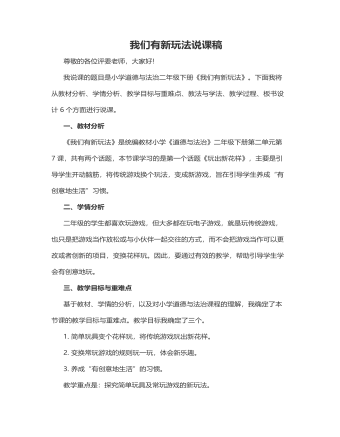
人教部编版道德与法制二年级下册我们有新玩法说课稿
活动三:游戏花样玩乐趣多课件出示儿歌《游戏玩法花样多》,学生自己诵读,再齐读。设计意图:学以致用,进一步感受游戏新玩法带来的快乐。环节三::感悟明理,育情导行学生谈一谈学习本节课的收获,教师相机引导。设计意图:梳理总结,体验收获与成功的喜悦,内化提升学生的认识与情感。环节四:拓展延伸,回归生活课间,和伙伴们一起变换花样玩游戏。设计意图:将课堂所学延伸到学生的日常生活中,有利于落实行为实践。六、板书设计为了突出重点,让学生整体上感知本节课的主要内容,我将以思维导图的形式设计板书:在黑板中上方的中间位置是课题《玩出新花样》,下面左边从上到下是简单玩具变个花样玩,变换游戏伙伴玩,变换玩具组合玩,右面是乐趣。我的说课完毕,谢谢各位评委老师!
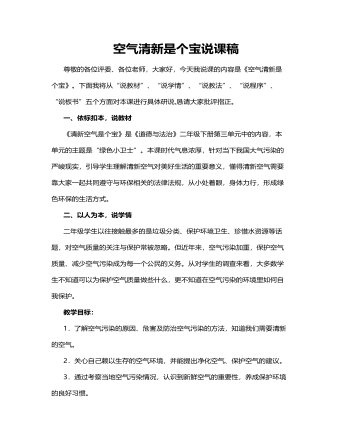
人教部编版道德与法制二年级下册空气清新是个宝说课稿
任务1:同学们,你们在课前调查中发现了哪些污染空气的现象?请将调查结果填写在《空气污染小调查》的表格中。学生活动:学生在全班汇报展示。任务2:从调查结果中我们还发现什么呢?学生活动:学生交流。教师小结:空气污染就在我们身边,大气污染带给我们一定的危害,我们一定要养成保护环境的好习惯。活动四:我能做些什么呢任务1:为防治大气污染,国家、政府做了大量工作,我们也做了很多力所能及的事情。那么,同学们计划怎样保护空气清新呢?学生活动:学生交流(如植树造林、使用新能源产品等、不放鞭炮、敢于举报严重污染大气的行为……)。教师小结:通过本节课的学习,我们知道了保护环境就是保护我们的家园,净化空气就要从身边的小事做起。
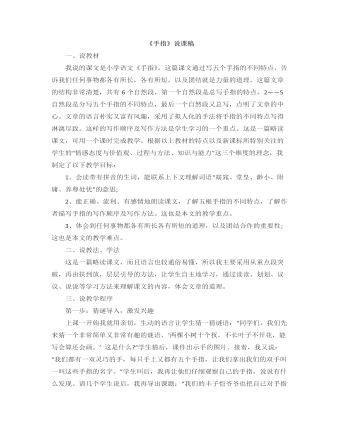
部编人教版五年级下册《手指》说课稿
非常清楚,共有6个自然段,第一个自然段是总写手指的特点,2——5自然段是分写五个手指的不同特点,最后一个自然段又总写,点明了文章的中心。文章的语言朴实又富有风趣,采用了拟人化的手法将手指的不同特点写得淋漓尽致。这样的写作顺序及写作方法是学生学习的一个重点。这是一篇略读课文,可用一个课时完成教学。根据以上教材的特点以及新课标所特别关注的学生的“情感态度与价值观、过程与方法、知识与能力”这三个维度的理念,我制定了以下教学目标:1、会读带有拼音的生词,能联系上下文理解词语“窈窕、堂皇、渺小、附庸、养尊处优”的意思;2、能正确、流利、有感情地朗读课文,了解五根手指的不同特点,了解作者描写手指的写作顺序及写作方法。这也是本文的教学重点。3、体会到任何事物都各有所长各有所短的道理,以及团结合作的重要性;这也是本文的教学难点。
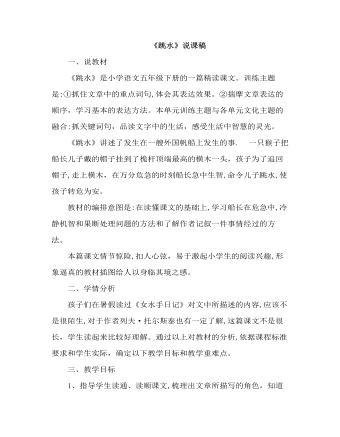
部编人教版五年级下册《跳水》说课稿
一、说教材《跳水》是小学语文五年级下册的一篇精读课文。训练主题是:①抓住文章中的重点词句,体会其表达效果。②揣摩文章表达的顺序,学习基本的表达方法。本单元训练主题与各单元文化主题的融合:抓关键词句,品读文字中的生活,感受生活中智慧的灵光。《跳水》讲述了发生在一艘外国帆船上发生的事. 一只猴子把船长儿子戴的帽子挂到了桅杆顶端最高的横木一头,孩子为了追回帽子,走上橫木,在万分危急的时刻船长急中生智,命令儿子跳水,使孩子转危为安。教材的编排意图是:在读懂课文的基础上,学习船长在危急中,冷静机智和果断处理问题的方法和了解作者记叙一件事情经过的方法。本篇课文情节惊险,扣人心弦,易于激起小学生的阅读兴趣,形象逼真的教材插图给人以身临其境之感。





















